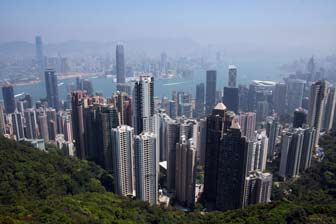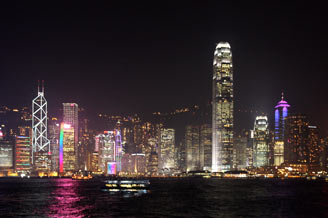|
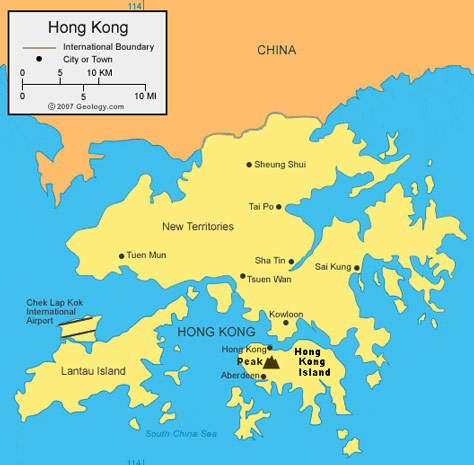 BACK-PACKING TRIP TO AUSTRALIA 2011
- Stop-over in Hong Kong: BACK-PACKING TRIP TO AUSTRALIA 2011
- Stop-over in Hong Kong:
A break with tradition: the Covid
Pandemic has brought enforced changes for all of us. For long term travellers
such as ourselves, lockdown has perforce meant a frustratingly extended period
excluded from the freedom to wander European roads that we had once been
accustomed to, and indeed had taken for granted. George, our faithful VW Camper
has spent the last 9 months confined to quarters in his garage; for us also, the
price of continuing good health has been to remain closeted in our rural home,
as the virus has with such devastatingly tragic impact rampaged around the
length and breadth of Europe. We scan without hope the daily deluge of government
emails announcing continuing closure of all the European borders which for so
many years the blessed St Schengen had kept open to us.
|
Map of Hong Kong |
 |
During this period, our travelling web site has
remained untouched, reflecting our own enforced inactivity and home confinement, suspended at the point of
progress it had reached just before lockdown struck. In early April we had been about to set
off on a 6 months period of travel around our beloved Scandinavia; our intention
had been to take final
advantage of the freedoms of Schengen during the so-called transition year, before
the indefensible, nonsensical madness of Brexit confines European travel access
to a maximum of 3 months in any
6 month period (apparently it's called taking back control if you can
make
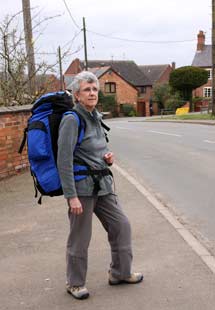 any sense of such meaningless clap-trap). But 4 weeks before our intended
April 2020 departure date for Scandinavia, lockdown-1 began. And there our web site has rested, like us in suspended animation
... until now. any sense of such meaningless clap-trap). But 4 weeks before our intended
April 2020 departure date for Scandinavia, lockdown-1 began. And there our web site has rested, like us in suspended animation
... until now.
We have
however during this 9 month period of lockdown
maintained our sanity by devoting time productively to writing up the draft logs and editing the photographs
from an earlier and as yet unwritten back-packing venture undertaken in March~May 2011.
The purpose of this 8 week back-packing trip, just prior to the start of our
summer 2011 travels to the Baltic States, was primarily to visit our younger daughter
Lucy who 3
years earlier had emigrated to Adelaide in South Australia. On the way, our plan
was to stop off for 2 days in Hong Kong, then make an 8 day visit to Sydney and the
Blue Mountains in New South Wales; we should then fly on to Adelaide for 4 weeks
to stay with our daughter, a period which would include a venture out to the
Flinders Ranges in the South Australian outback and a week on Kangaroo Island off
the SA coast in a hired camper. Our return flight would give us 2 day stop-overs in
both Perth Western Australia and in Singapore. Apart from our stay in Adelaide with
Lucy our daughter, we should along the way use back-packing hostels.
This venture's logs and photographs have
however remained in the box where they were deposited on our return from Australia 9
years ago, prior to resumption of our regular 2011 European travels in our campervan
and our first
visit to the Baltic States in June 2011. It is time these travel logs saw the light of day.
Until now our web site's purpose, as its name implies (Travels in a VW Camper),
has been to document our European travels with George our VW Camper. But
extraordinary times justify changes, and the web site has been on hold for far
too long: we shall now therefore, pending our ability to continue travelling with George,
resume our web publications with a new and illustrated series of travels, covering our Far
Eastern back-packing venture - Australia 2011. Episode 1 covers
our delightful 2 day stop-over in Hong Kong.
Departure from Heathrow on our Far Eastern
back-packing trip: our plan was to catch the then local bus from our village (long since
axed along with so much other rural public transport in the constant round of Tory
cuts) into Leicester, then the express coach to Heathrow. We had allowed ourselves plenty of
time in case of bus cancellations, and plodded up the hill with our fully
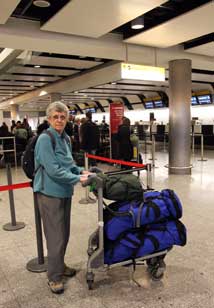 loaded
packs and immediate requirements stowed in day-sacs (Photo
1 - Our 2011 Australia back-packing trip begins) (see above left). Trial loadings were well within the airline's
specified weight restrictions. Up at the church we stood waiting as the clock
ticked up to and beyond 12-00 noon; what should we do if the bus failed to turn up? But to our relief, the bus arrived
and we struggled aboard with our packs. Bus passes would be an essential
accompaniment this trip to prove our entitlement to seniors' reductions.
At loaded
packs and immediate requirements stowed in day-sacs (Photo
1 - Our 2011 Australia back-packing trip begins) (see above left). Trial loadings were well within the airline's
specified weight restrictions. Up at the church we stood waiting as the clock
ticked up to and beyond 12-00 noon; what should we do if the bus failed to turn up? But to our relief, the bus arrived
and we struggled aboard with our packs. Bus passes would be an essential
accompaniment this trip to prove our entitlement to seniors' reductions.
At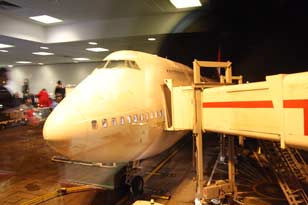 Leicester bus station, we lumbered out for the coach; packs were stowed in the luggage hold, and we enjoyed a comfortably
relaxed journey down to Heathrow in the uncrowded coach. The weather until today had
been beautiful with warm, sunny Spring conditions, but the forecast for today
was for heavy rain, just what we did not need. Leicester bus station, we lumbered out for the coach; packs were stowed in the luggage hold, and we enjoyed a comfortably
relaxed journey down to Heathrow in the uncrowded coach. The weather until today had
been beautiful with warm, sunny Spring conditions, but the forecast for today
was for heavy rain, just what we did not need.
Immediately we emerged from
the coach at Heathrow, Sheila grabbed a trolley for our heavy packs (see left), and we
trundled our way through to the Terminal 3 departure area. After a half hour
wait, we were able to complete our checking-in and hand over our hold-luggage
packs, with no quibbles about their being over-weight. Up at the departure area,
the next obstacle was to pass through the security check without this causing
undue stress. We had been forewarned about precautions: Paul removed his belt
(metal buckle), took
the laptop from the day-sac, and alerted the security officer to our supplies of medications,
being sure to smile nicely (as instructed by our travel-wise daughter!). All to good effect, and that obstacle
was passed without undue hassle. We had reached the airport at 4-30pm, and even
after we had checked in packs and passed through security, it was still only
5-45pm; we now had over 3 hours to spend amid all the commercialised hullabaloo
of the over-priced, allegedly duty-fee shops. After a long wait, the monitors
announced the gate number for our overnight Hong Kong flight, and from the waiting lounge,
we could look out onto the huge nose of the Qantas 747 (see right). Around 10-00pm we boarded,
found our pre-booked seats, and spent the time until take-off trying to figure
out the controls of the audio-visual screens on the seat-back. At 10-30pm the
plane trundled out along the taxi-way, and suddenly we were off, accelerating
along the runway and soon climbing in spectacular fashion above London. We soon
discovered the real-time visual flight progress plan, and spent the next hour
following our passage across the Baltic, and along the Daugava Valley through
Latvia, on over Belarus and south of
Moscow. As we passed over Riga, we called down saying we should see the city
again in 3 months. Weary after such a fulsome day, reasonable supper and
miniature bottles of Aussie wine, we settled down with our pillow and
blanket as the cabin lights were dimmed, and slept
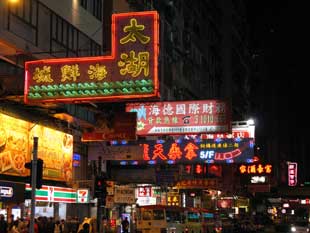 reasonably soundly for 6~7
hours. Our Far Eastern venture was underway. reasonably soundly for 6~7
hours. Our Far Eastern venture was underway.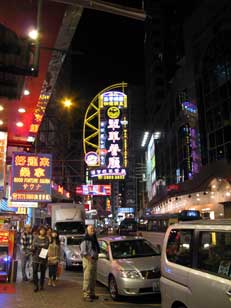
Arrival in Hong Kong:
we woke around 7-00am London time, 4-00pm Hong Kong time, to be served
breakfast; today was only a part day because of the time zone differences. The flight
progress monitor showed us now almost across China with the map display showing
unknown place names, and approaching Hong Kong. The plane began its descent,
circling around the island, to land from the northern side
with spectacular mountainous views on the approach to Hong Kong's International
Airport on the outer western side of Lantau Island (see map of Hong Kong at top of
page). We landed at around 5‑15pm
Hong Kong time with the sun bright and air temperature around 25°C on a very
pleasant afternoon. After the lengthy queuing to clear immigration, we reclaimed
our packs from the carousel, loaded them onto a trolley, and raided the
Tourist Information Centre (TIC) for Hong Kong plans and MTR airport express
tickets for the ride into the city.
Struggling with our packs and day sacs, we boarded the speedy and spotlessly
clean Metro which conveyed us within 25 minutes to Hong Kong Central. By now
ultra-weary with our burdensome packs, we changed to the city Metro Line, bought
tickets from the machine and caught the Hong Kong Island MTR line (Hong
Kong Mass Transit Railway Metro) along to North Point station, hoping
that the Ibis Hotel where we were booked was not a further undue walk. When we
eventually emerged from the huge station with its endless corridors and
escalators, we were relieved to see our hotel's sign just 50m along the main
road. We were welcomed with calm efficiency by the young receptionist, who
booked us in showing due understanding at our weary state; she recommended a
return to 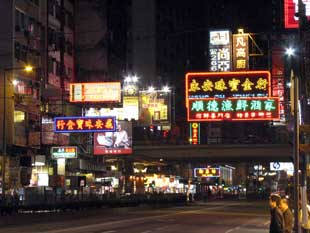 Causeway Bay MTR station for supper amid all the shopping malls there. Causeway Bay MTR station for supper amid all the shopping malls there.
Our first evening in Hong Kong: our room was high in the hotel's tower-block, which in
fact rose a further 10 storeys above us; but by now it was 8-00pm and totally
dark so impossible to see any details of the city. The Light Show was not
visible from our window so it was impossible to determine whether our room overlooked the harbour as
requested. Having washed, refreshed and briefly sorted kit, we sent a text to
our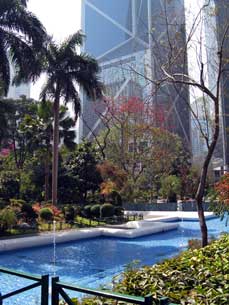 daughter to say that, despite being exhausted, we were heading out in
search
of beer, food and fun (in that order!).
We returned to the MTR station, and at
Causeway Bay emerged into the glare of characteristic Hong Kong illuminated
signs (see above left and right) (Photo 2 - Illuminated signs),
totally bemused by our surroundings. Just around the corner, we took the
chance on a small restaurant, the Macau Restaurant, and were led up to the first
floor. Amid all the fascinating surroundings, we each ordered supper of fried noodles with a
variety of sea
foods, all quite delicious (Photo 3 - Chinese supper).
The TV was showing Chinese news which, rather symbolically, seemed to indicate
rising financial markets. After supper we
wandered along the busy streets, photographing the illuminated signs, and found
the Wai Wai Japanese Restaurant for glasses of Asahi Japanese beer. It was
by now gone 11-00pm; with the city still in full swing and all the shops still
open, we returned wearily to the Ibis Hotel, glad of our first night's sleep. daughter to say that, despite being exhausted, we were heading out in
search
of beer, food and fun (in that order!).
We returned to the MTR station, and at
Causeway Bay emerged into the glare of characteristic Hong Kong illuminated
signs (see above left and right) (Photo 2 - Illuminated signs),
totally bemused by our surroundings. Just around the corner, we took the
chance on a small restaurant, the Macau Restaurant, and were led up to the first
floor. Amid all the fascinating surroundings, we each ordered supper of fried noodles with a
variety of sea
foods, all quite delicious (Photo 3 - Chinese supper).
The TV was showing Chinese news which, rather symbolically, seemed to indicate
rising financial markets. After supper we
wandered along the busy streets, photographing the illuminated signs, and found
the Wai Wai Japanese Restaurant for glasses of Asahi Japanese beer. It was
by now gone 11-00pm; with the city still in full swing and all the shops still
open, we returned wearily to the Ibis Hotel, glad of our first night's sleep.
Hong Kong Island Peak and views across to
Kowloon: on pulling up the blind this morning,
we let out an explanation of Wow! What a
fantastic view from our window over Hong Kong harbour greeted us (Photo 4 - View over Hong Kong harbour).
Despite the semi-hazy glazing, photos simply
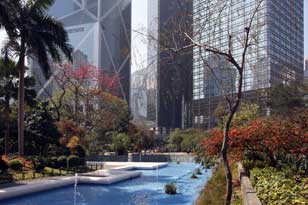 had to be taken of such a view. We were away early
this morning for our first full day in Hong Kong, and caught the MTR back to Central.
Our intention today was to take the peak tram funicular up to the Peak viewing
platform, given that the forecast was for clearer, less hazy sunny weather; we
should then cross the Harbour by the Star Ferry for lunch in Kowloon. Our plan
was
to spend the afternoon visiting the markets area of Kowloon, see the Light Show
from the waterfront viewing platform early evening, then return to Causeway Bay
for supper and for photographing the illuminated street signs. had to be taken of such a view. We were away early
this morning for our first full day in Hong Kong, and caught the MTR back to Central.
Our intention today was to take the peak tram funicular up to the Peak viewing
platform, given that the forecast was for clearer, less hazy sunny weather; we
should then cross the Harbour by the Star Ferry for lunch in Kowloon. Our plan
was
to spend the afternoon visiting the markets area of Kowloon, see the Light Show
from the waterfront viewing platform early evening, then return to Causeway Bay
for supper and for photographing the illuminated street signs.
Our reaction on emerging from the MTR at
Central into the glaringly bright sunlight was the second Wow! of the day: Chater Gardens was full of
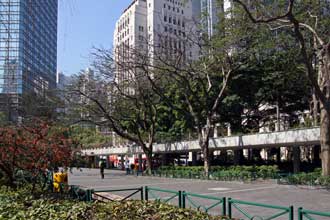 tropical
trees, flower-beds and fountains, towered over by a surrounding forest of sky scraper office
blocks (see left and right) (Photo
5 - Chater Gardens). These magnificent surroundings were backed by the Hong Kong Island Peak
where we were heading this morning (Photo
6 - Hong Kong Peak's tower-blocks). Such a glorious setting and views
looking up towards the Peak, well-lit by the bright morning sunshine, demanded many
photos (Photo
7 - Hong Kong Island city-scape) (see right). We walked up through the park and the
traffic-filled streets amid the tower-blocks, and up the hill to the Peak Tram
lower station (see below left) (Photo
8 - Peak Tram) for senior return tickets (without having to show our bus
passes!) at a reasonable $31 each. At this time of the morning, the queues were
not at all bad and we got seats on the tropical
trees, flower-beds and fountains, towered over by a surrounding forest of sky scraper office
blocks (see left and right) (Photo
5 - Chater Gardens). These magnificent surroundings were backed by the Hong Kong Island Peak
where we were heading this morning (Photo
6 - Hong Kong Peak's tower-blocks). Such a glorious setting and views
looking up towards the Peak, well-lit by the bright morning sunshine, demanded many
photos (Photo
7 - Hong Kong Island city-scape) (see right). We walked up through the park and the
traffic-filled streets amid the tower-blocks, and up the hill to the Peak Tram
lower station (see below left) (Photo
8 - Peak Tram) for senior return tickets (without having to show our bus
passes!) at a reasonable $31 each. At this time of the morning, the queues were
not at all bad and we got seats on the
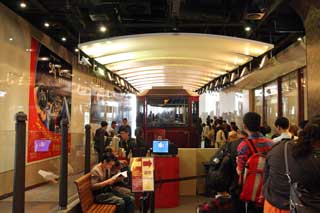 second tram which trundled up the
peak-side passing the down-coming tram (Photo
9 - Up the hill-side on Peak Tram). The tram wound steeply up the
hill-side between the tower-blocks giving increasingly spectacular
views over the city spread out below, to draw into the upper station at
the saucer-shaped viewing platform. Up the escalators amid tacky souvenirs
shops, we emerged onto the airy viewing platform, with remarkably few other
tourists about. Although the distant views over to Kowloon was still rather
hazy, the panorama which opened out over the forest of skyscraper office blocks
spread over Hong Kong Island Peak's lower slopes and across the distant harbour
was simply magnificent (Photo
10 - Hong Kong panorama). We spent 15 minutes gazing out across Hong
Kong's city-scape and harbour second tram which trundled up the
peak-side passing the down-coming tram (Photo
9 - Up the hill-side on Peak Tram). The tram wound steeply up the
hill-side between the tower-blocks giving increasingly spectacular
views over the city spread out below, to draw into the upper station at
the saucer-shaped viewing platform. Up the escalators amid tacky souvenirs
shops, we emerged onto the airy viewing platform, with remarkably few other
tourists about. Although the distant views over to Kowloon was still rather
hazy, the panorama which opened out over the forest of skyscraper office blocks
spread over Hong Kong Island Peak's lower slopes and across the distant harbour
was simply magnificent (Photo
10 - Hong Kong panorama). We spent 15 minutes gazing out across Hong
Kong's city-scape and harbour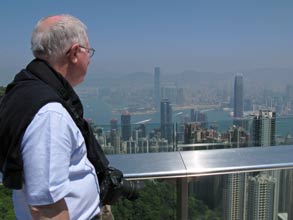 , and photographing this glorious
vista
(see below right)
(Photo
11 - Peak viewing platform vista). In the distance, ferries could be seen
buzzing back and forth across the harbour, and beneath us on the viewing
platform trams passed by up and down the Peak's wooded higher slopes
(Photo
12 - Peak Tram upper station). Having photographed the up-coming Peak Tram,
we returned to the upper station to catch the next tram down, winding steeply
down the Peak (see below left ), around
the foot of the tower-block apartments spread across the hill-side, and down to
the now bustling lower station. , and photographing this glorious
vista
(see below right)
(Photo
11 - Peak viewing platform vista). In the distance, ferries could be seen
buzzing back and forth across the harbour, and beneath us on the viewing
platform trams passed by up and down the Peak's wooded higher slopes
(Photo
12 - Peak Tram upper station). Having photographed the up-coming Peak Tram,
we returned to the upper station to catch the next tram down, winding steeply
down the Peak (see below left ), around
the foot of the tower-block apartments spread across the hill-side, and down to
the now bustling lower station.
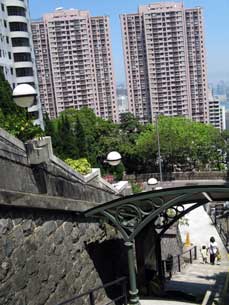 Star Ferry across
Victoria Harbour for lunch in Kowloon: we walked downhill
through the city, photographing Hong Kong's
city trams and double-decker buses (see below right) (Photo
13 - Hong Kong trams), a legacy from British colonial days. This
led us all the way down past Central station to the ferry landing stages
to board the ferry across the harbour (Photo
14 - Star Ferry terminal). The Star Ferry from Hong Kong
Island across Victoria Harbour to Kowloon has been operating for over 100 years
and still carries over 70,000 passengers per day. Even though the harbour is now crossed
by railway and road tunnels, the Star Ferry continues to provide an inexpensive
mode of harbour crossing, at the remarkably good value price of $2 per ticket.
It is also a wonderfully picturesque experience with unparalleled views from the small ferry boat during the harbour crossing. Star Ferry across
Victoria Harbour for lunch in Kowloon: we walked downhill
through the city, photographing Hong Kong's
city trams and double-decker buses (see below right) (Photo
13 - Hong Kong trams), a legacy from British colonial days. This
led us all the way down past Central station to the ferry landing stages
to board the ferry across the harbour (Photo
14 - Star Ferry terminal). The Star Ferry from Hong Kong
Island across Victoria Harbour to Kowloon has been operating for over 100 years
and still carries over 70,000 passengers per day. Even though the harbour is now crossed
by railway and road tunnels, the Star Ferry continues to provide an inexpensive
mode of harbour crossing, at the remarkably good value price of $2 per ticket.
It is also a wonderfully picturesque experience with unparalleled views from the small ferry boat during the harbour crossing.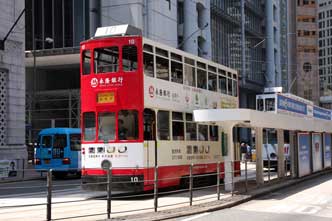
As the ferry drew away from the terminal (Photo
15 - Departing Central ferry-terminal) (see below left), the spectacular Hong Kong Island
waterfront skyline of tower-blocks opened up before us, with one particular slender office
building standing markedly taller than its neighbours (Photo 16 -
Harbour-side skyline of tower-blocks). Victoria Harbour was busy with
returning Star ferries and other small boats criss-crossing the narrow waterway (Photo
17 - Boats crossing Victoria Harbour). The crossing gave plenty of
opportunity for photographs of the skyscraper-lined waterfront on both sides of
the harbour, particularly the Hong Kong Island
side with the Peak where we had been earlier silhouetted against the clear
morning sky (Photo
18 - Hong Kong Island waterfront) (see below right). Approaching Kowloon waterfront,
the ferry docked at Tsim Sha Tsui terminal and we stepped ashore on the mainland
side of the harbour.
With all the photographic potential of Hong
Kong's novel surroundings, both our camera memory cards were already filling rapidly since leaving home.
We
now
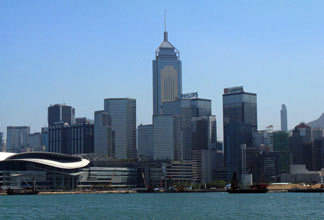 tried an electronics shop close to the Kowloon ferry
landing stage to discover how far the price of higher value memory cards could
be haggled down. On the Nathan Road we found a more promising photographic shop; here by
persistent bargaining,
we managed to achieve a satisfyingly reasonable price for high capacity cards to
equip tried an electronics shop close to the Kowloon ferry
landing stage to discover how far the price of higher value memory cards could
be haggled down. On the Nathan Road we found a more promising photographic shop; here by
persistent bargaining,
we managed to achieve a satisfyingly reasonable price for high capacity cards to
equip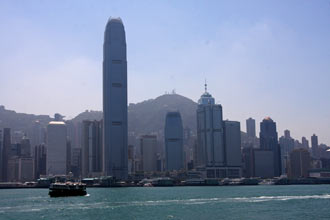 both our cameras. both our cameras.
Din Sum lunch in Kowloon: we walked along to Tsim Sha Tsui MTR station, a huge complex of
passageways and walk-ways, with the intention of finding a dim sum lunch in the
back streets of Kowloon around Nathan Road. We had earlier learned that dim sum is a traditional
Cantonese dish, prepared as small, bite-sized portions of meat or vegetable cooked in small steamer-baskets, and
served for breakfast or lunch, usually accompanied with tea (yum cha in Cantonese means drink tea,
from which English had derived the colloquial expression cup of cha). By now it was 1-30pm and, tired and
hungry, we wandered along the crowded, traffic ridden and rather seedy side
streets in search of lunch.
There were plenty of intriguingly inviting
small cafés but none
serving dim sum, at least not as far as we could understand, and none displayed
the characteristic little steamer baskets we had been told to look out for. In desperation we caught the MTR one
stop further to Jordan station, and again searched the back streets.
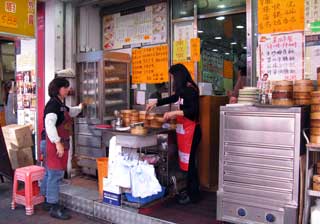 Having tried
one grubby-looking café asking for dim sum, we were directed across the
street to where we found piles of the little baskets cooking outside an
initially unpromising café
(see left) (Photo
19 - Kowloon Dim Sum café). But nothing ventured we enquired about
lunch of dim sums: the lady showed us inside, invited us to sit down at a table and brought out baskets
of prawn and Having tried
one grubby-looking café asking for dim sum, we were directed across the
street to where we found piles of the little baskets cooking outside an
initially unpromising café
(see left) (Photo
19 - Kowloon Dim Sum café). But nothing ventured we enquired about
lunch of dim sums: the lady showed us inside, invited us to sit down at a table and brought out baskets
of prawn and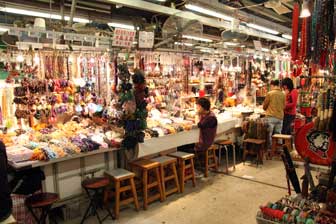 pork dim sums, and naturally a pot of China tea. Hesitantly, and rather
inexpertly, we picked up the little round crispy parcels of meat with our chop sticks to eat
without dropping them (Photo
20 - Dim Sum lunch). We each ordered more dim sums from the lists
displayed on the café wall, and then ventured
onto other items: Paul tried squid in curry and Sheila bravely moved on to chickens' feet. A
cold beer would
have been welcome, but we had to be content with more tea. It was one of the
more curious lunch occasions of our travels: the dim sum were an
interesting experience but, it has to be said, a lot of effort for little taste! pork dim sums, and naturally a pot of China tea. Hesitantly, and rather
inexpertly, we picked up the little round crispy parcels of meat with our chop sticks to eat
without dropping them (Photo
20 - Dim Sum lunch). We each ordered more dim sums from the lists
displayed on the café wall, and then ventured
onto other items: Paul tried squid in curry and Sheila bravely moved on to chickens' feet. A
cold beer would
have been welcome, but we had to be content with more tea. It was one of the
more curious lunch occasions of our travels: the dim sum were an
interesting experience but, it has to be said, a lot of effort for little taste!
Kowloon Jade Market:
we crossed Nathan Road and along Kansu
Street found the Jade Market in a covered area of stalls (see right and below
left)
(Photo
21 - Kowloon Jade Market). Here we
happily ambled among the stalls initially taking photos, but paused at a smaller
stall kept by an elderly couple. We browsed through the stall-holders' wares (Photo
22 - Souvenir jade gifts) and bought a jade bracelet each for Sheila and our
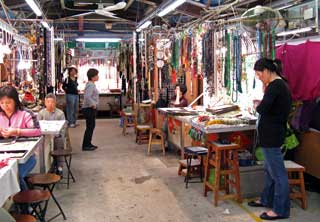 older daughter, and after some confusion over price, succumbed to a jade pendant
for Sheila at a rather more expensive price; 'promotion' he added insistently.
We were easy victims! older daughter, and after some confusion over price, succumbed to a jade pendant
for Sheila at a rather more expensive price; 'promotion' he added insistently.
We were easy victims!
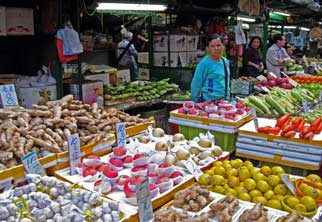 Browsing the
street markets of Kowloon:
just opposite we could see an area of open
street markets, and wandered among the stalls; all kinds of fruit and
vegetables were on display (Photo
23 - Fruit and vegetable stalls) (see right), many exotically unrecognisable, and the shops alongside
the market were filled with grotesquely laden meat stalls and live fish in tanks or set out on trays
(Photo
24 - Fish and meat stalls) (see below left). We ambled
slowly through, browsing the stalls, taking photos, and feeling very self-conscious and obviously intrusive
among the shoppers and stall-holders
(Photo
25- Browsing the market stalls). But it was all so fascinating and so much more
interesting and seedy than the brash, glitzy shops of Nathan Road or Hong Kong Island. Part-way through the market, we paused for lemon tea at a market café,
spellbound by all the bustling surroundings: men were frantically preparing noodles in
the café kitchen, a legless beggar dragged himself past, buskers in wheelchairs
attracted no attention from shoppers. We were in our element in the lively
atmosphere of these oriental produce markets (see below right). Browsing the
street markets of Kowloon:
just opposite we could see an area of open
street markets, and wandered among the stalls; all kinds of fruit and
vegetables were on display (Photo
23 - Fruit and vegetable stalls) (see right), many exotically unrecognisable, and the shops alongside
the market were filled with grotesquely laden meat stalls and live fish in tanks or set out on trays
(Photo
24 - Fish and meat stalls) (see below left). We ambled
slowly through, browsing the stalls, taking photos, and feeling very self-conscious and obviously intrusive
among the shoppers and stall-holders
(Photo
25- Browsing the market stalls). But it was all so fascinating and so much more
interesting and seedy than the brash, glitzy shops of Nathan Road or Hong Kong Island. Part-way through the market, we paused for lemon tea at a market café,
spellbound by all the bustling surroundings: men were frantically preparing noodles in
the café kitchen, a legless beggar dragged himself past, buskers in wheelchairs
attracted no attention from shoppers. We were in our element in the lively
atmosphere of these oriental produce markets (see below right).
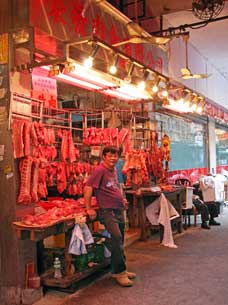 Kowloon Park: we continued through the
market, ambling among the stalls, traders and shoppers, and beyond the Jordan Road we
passed through areas of small shops selling all kinds of household goods, all so
interesting. This emerged at a more modern shopping plaza which blocked our way
forward. Around the side of this we entered the attractive Kowloon Park where we
were glad to sit a Kowloon Park: we continued through the
market, ambling among the stalls, traders and shoppers, and beyond the Jordan Road we
passed through areas of small shops selling all kinds of household goods, all so
interesting. This emerged at a more modern shopping plaza which blocked our way
forward. Around the side of this we entered the attractive Kowloon Park where we
were glad to sit a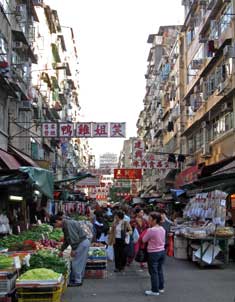 while, weary from our wanderings, and watch the passers-by.
Birds of prey circled around the surrounding tower-blocks and exotically
coloured parakeets flitted among the trees. Sheila admired the Chinese Banyan trees (Ficus
microcarpa)
(Photo
26 - Chinese Banyan Tree), and we photographed the flamingos in the aviary ponds
(Photo
27 - Flamingos in Kowloon Park). But by now it was gone 5‑00pm and the sun was
beginning to set behind the tower-blocks. We ambled back through the park, and
emerged onto Haiphong Road which was filled with traffic and crowded with
hustling evening pedestrians. At a corner photographic store, we haggled a
better price for a camera mini-tripod, and in the gathering evening dusk fought a way through the crowds of pedestrians,
touts, begging monks and tourists along by the garish shops of Nathan Road down
to Salisbury Road. while, weary from our wanderings, and watch the passers-by.
Birds of prey circled around the surrounding tower-blocks and exotically
coloured parakeets flitted among the trees. Sheila admired the Chinese Banyan trees (Ficus
microcarpa)
(Photo
26 - Chinese Banyan Tree), and we photographed the flamingos in the aviary ponds
(Photo
27 - Flamingos in Kowloon Park). But by now it was gone 5‑00pm and the sun was
beginning to set behind the tower-blocks. We ambled back through the park, and
emerged onto Haiphong Road which was filled with traffic and crowded with
hustling evening pedestrians. At a corner photographic store, we haggled a
better price for a camera mini-tripod, and in the gathering evening dusk fought a way through the crowds of pedestrians,
touts, begging monks and tourists along by the garish shops of Nathan Road down
to Salisbury Road.
Hong Kong Light-Show from the illuminated harbour-side waterfront:
around by the Clock Tower and the Star Ferry terminal, we found the raised
observation area at Tsim Sha Tsui waterfront recommended for watching the Light
Show. Tourists were already beginning to gather along the viewing platform as it
was by now 7‑30pm. We took up position along the front rail, staring in
amazement at the spectacular skyline of Hong Kong Island waterfront with its
parade of illuminated tower-blocks directly opposite on the far side of the harbour (Photo
28 - Illuminated tower-blocks). This in itself was an inspirational sight
with the backdrop of illuminated tower blocks lining the harbourside waterfront (Photo
29 - Harbour backdrop) (see below left) and ferries and other smaller craft criss-crossing the
water (Photo
30 - Boats crossing harbour). We each prepared our camera exposures in
readiness for the Light Show to begin, as the crowds of spectators swelled. The
introductory commentary from loudspeakers set in the platform wall was given in
both Chinese and English in a sing-song almost parody-sounding intonation. When
it finally began, the Light Show was a truly climactic spectacle, even more so
than the dramatically illuminated panorama of the Victoria Harbour waterfront itself.
As the lighting on individual buildings ranged through varying shades of greens,
reds and yellows, alternating sequences of flashing light shafts probed the
night sky (see below centre) (Photo
31 - Light Show flashing light beams), with green laser beams arcing and stabbing skywards from the tops of
tower blocks (see below right) (Photo 32 - Light Show laser beams).
The dramatic atmosphere was heightened by the surroundings amid the architecturally monumental setting of the
illuminated harbour-side and waterfront
(Photo
33 - Hong Kong Light Show); it was without doubt one
of the most impressively memorable spectacles ever witnessed.
Ferry back to Hong Kong
Island: we took our photos, and as the
Light Show ended and the audience began to drift away, we made our way back through the
crowds to the Star Ferry terminal.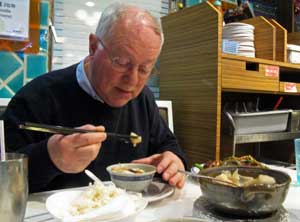 Re-crossing the harbour, we took yet more photos
looking across towards the far bank waterfront with the highest tower on the Hong Kong Island shore ahead now illuminated
and silhouetted against
the night sky (Photo
34- Re-crossing harbour on Star Ferry), as the ferry approached the Central pier from
where we had departed earlier in the day (Photo
35 - Approaching Central ferry-pier). Re-crossing the harbour, we took yet more photos
looking across towards the far bank waterfront with the highest tower on the Hong Kong Island shore ahead now illuminated
and silhouetted against
the night sky (Photo
34- Re-crossing harbour on Star Ferry), as the ferry approached the Central pier from
where we had departed earlier in the day (Photo
35 - Approaching Central ferry-pier).
Chinese supper and more after-dark street
photos: back on Hong Kong
Island, we walked up to Central Station and caught the MTR back to Causeway Bay.
One of the most pleasantly memorable features about Hong Kong had been just how
safe the streets felt; we had naturally taken all the usual precautions against
pick-pockets, but generally, even after dark, it had never felt threatening or
unsafe. Having taken yet more after-dark
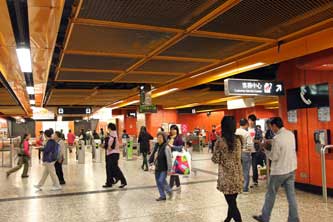 street photos of all the illuminated
signs (Photo
36 - Illuminated signs), we again went for supper at the Macau Restaurant
(see right);
the place was welcoming, the food was tasty and good value, and we were simply too weary
after a long day to search
for another place to eat. The young waiter taught us how to say thank you in
Mandarin – do-ze. After supper we walked along for another Asahi beer at
the Japanese bar, where the friendly owner, an ex-pat, Chinese-speaking American, offered
us samples of Japanese potato vodka. It was a fitting evening to conclude our
excellent first day in Hong Kong, and it was almost midnight before we were back
at the Ibis Hotel to sort our kit ready for tomorrow. street photos of all the illuminated
signs (Photo
36 - Illuminated signs), we again went for supper at the Macau Restaurant
(see right);
the place was welcoming, the food was tasty and good value, and we were simply too weary
after a long day to search
for another place to eat. The young waiter taught us how to say thank you in
Mandarin – do-ze. After supper we walked along for another Asahi beer at
the Japanese bar, where the friendly owner, an ex-pat, Chinese-speaking American, offered
us samples of Japanese potato vodka. It was a fitting evening to conclude our
excellent first day in Hong Kong, and it was almost midnight before we were back
at the Ibis Hotel to sort our kit ready for tomorrow.
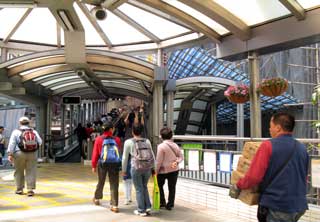 Our
second day in Hong Kong Our
second day in Hong Kong
:
after a sound night's sleep following our exhausting first day, we woke early
for Paul to write yesterday's log
and Sheila to read up on our second day in
Hong Kong. On opening the blind this morning, the sky was obscured by a heavy
mist-haze, but with hints of blue sky shining through. By the time we were ready
to set off, the mist had burned off and sun was shining warmly. Kit was sorted and
re-packed before breakfast and the room checked before we settled our account.
The reception staff were both courteous and helpful, and we were more than
satisfied with the receipted secure arrangements for leaving kit in a locked
store during our final day, ready to collect late afternoon before leaving for
the airport.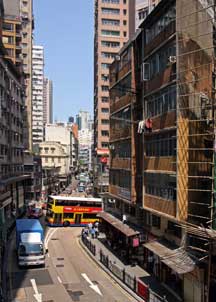
Mid-levels escalator up the Peak hill-side above Sheung Wan:
our plan for today was to explore the higher parts of the Middle Levels on the
Peak hill-side above Sheung Wan, by rising up the Mid-Levels Escalator. We again
caught the MTR along to Central (see above left), and emerged into bright sun light in the crowds
and busy traffic of Des Voeux Road. Another memory was of Hong Kong pedestrians
even on the Metro wearing face masks as precaution against polluted air
(Photo
37 - Wearing of face masks), though
on a bright morning this all seemed unnecessary. In retrospect now, we could not
realise at the time how the wearing of face-masks would in today's post-Covid world become
the norm! We fought our way through the
Saturday morning crowds to access the bottom of the Escalator in Connaught Road
(see above right).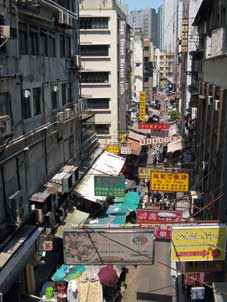
The Escalator consisted of a covered way with
moving walk-ways rising most of the way up the hill-side, with steps alongside
(Photo
38 - Mid-levels covered-way escalator).
The covered way passed through the heart of tower-blocks on the lower slopes,
crossing roads between buildings, and higher up giving a bird's eye view along side streets busy with
buses and traffic (see left) (Photo
39 - Traffic-ridden side streets), and over the Peak hill-side
city-scape with its back streets of commercial premises (see right) (Photo
40 - Back-street commercial premises). Above this, the automated covered
walk-way ascended through the steeper middle reaches, rising to higher
residential areas of the crowded hill-side
(Photo
41 - Hill-side of apartments blocks). We could look out from the open
side of the walk-way steps up towards the ranks of apartment blocks spread across the
hill-side above (Photo
42 - View from Escalator steps). Most of those using the Escalator were local people
with surprisingly few tourists about. We hopped off and on the Escalator at frequent intervals
to take photos, enjoying the atmosphere of these less tourist-frequented,
residential and commercial areas of the city, and seeing local people going
about their daily lives
(Photo
43 - Local residents).
Thankful that the ascent of the steep hill-side
was by automated walk-way, we reached the top of the Escalator at Conduit Road;
from here
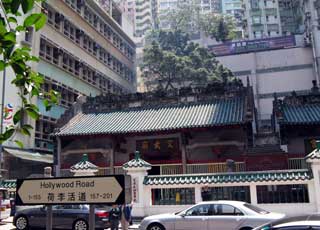 we turned back down the steps alongside the Escalator (Photo
44 - Descending Escalator steps), descending as far as Mosque Street which crossed
at this point. The view from here gave a perfect impression of the Escalator and side-steps rising
up among the buildings and apartment blocks of the crowded hill-side (Photo
45 - Escalator at Mosque Street). we turned back down the steps alongside the Escalator (Photo
44 - Descending Escalator steps), descending as far as Mosque Street which crossed
at this point. The view from here gave a perfect impression of the Escalator and side-steps rising
up among the buildings and apartment blocks of the crowded hill-side (Photo
45 - Escalator at Mosque Street).
Across the road the steps continued further down the hill-side to
the half-way stage at Hollywood Road. This was a very functional area, and the
side roads crossing the steps and Escalator covered-way were busy with traffic. We turned
along Hollywood Road, passing a huge Chinese Banyan tree whose aerial roots overhung a
side-wall. Along here we reached the picturesque Man Mo Buddhist Temple, rather
insignificant from the outside and dwarfed by the over-towering apartment blocks
high on the
hill-side above
(Photo
46 - Man Mo Buddhist Temple) (see left). The temple was built
in 1847 and dedicated to the Buddhist God of Literature (Man) and the God of War (Mo),
both of whom were worshipped by students ambitious to succeed in the civil
examinations of Imperial China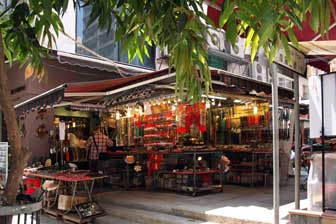 during the Ming and
Qing dynasties; the temple is now maintained by the Tung Wah charitable organisation
which provides hospital and school services across Hong Kong. The temple's dark
interior was filled with shrines and the air was rank with incense smoke from
burning joss sticks and smoking bell-shaped incense coils hanging from the
ceiling. Worshippers were paying homage to their Buddha statues with handfuls of
burning joss sticks. during the Ming and
Qing dynasties; the temple is now maintained by the Tung Wah charitable organisation
which provides hospital and school services across Hong Kong. The temple's dark
interior was filled with shrines and the air was rank with incense smoke from
burning joss sticks and smoking bell-shaped incense coils hanging from the
ceiling. Worshippers were paying homage to their Buddha statues with handfuls of
burning joss sticks.
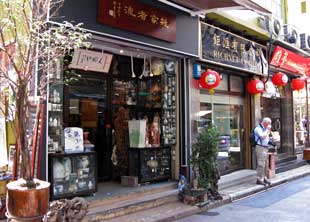 A straightforward lunch in Lok Ku Street: A straightforward lunch in Lok Ku Street: we
continued down the steps of the aptly named Ladder Street and turned along
through Cat Street which was
filled with market stalls selling Chinese antiques and bric-a-brac (see right)
(Photo
47 - Cat Street market stalls). We ambled through the market browsing
among the stalls and turned back at the far end along Lok Ku Road and Hillier Street, a narrow alleyway filled with
furniture
workshops and more bric-a-brac stalls
(Photo
48 - Workshops and bric-a-brac stalls). By now after all this exploration of
the Sheung Wan hill-side back streets, we were ready for some lunch, and in Jervois Street
we found a small, functional Chinese
café. Lists of available dishes were displayed on the walls but only in Chinese;
the lady however was most welcoming and brought us a menu with some
English. The Chinese regulars here seemed far more sensible than those across in
Kowloon, most not bothering with chop-sticks and tucking into their bowls of
lunch with forks and spoons. Outside in the street, we stood in amazement
watching and photographing 3 men erecting bamboo scaffolding high on a shop
front, simply lashing together the poles with plastic cable-ties (see below)
(Photo
49 - Hong Kong scaffolders at work). The climbing
skills and sense of poise and aplomb of these Chinese scaffolders as they
flitted around on the bamboo framework across the high face of the building had to be admired;
the sight even
caused passing local Chinese to pause and stare in wonderment. The bamboo scaffolding looked so flimsy,
as if it would bear no weight; and there was no presence here of the Health and
Safety restrictions which would operate in Europe.
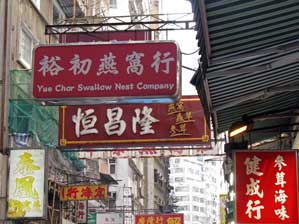
Wing
Lok Street and a game of Jianzi:
continuing down Hillyer Street, we reached Wing
Lok Street (see left) which was filled with emporia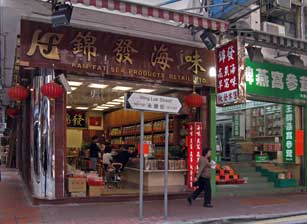 selling all kinds of exotic and
unrecognisable dried ingredients for Chinese hokus-pokus medicine (Photo
50 - Chinese medicine emporia) (see right), stocked in
jars high on shelves in shop windows or in sacks stacked outside the shops
(Photo
51 - Shop's street displays). At
the far end of Win Lok Street in a small square we stood again transfixed watching a group of men
skilfully playing the traditional Chinese game of Jianzi (kick-shuttlecock),
flick-kicking a large shuttlecock between themselves
(Photo
52 - Chinese game of Jianzi) (see below left). The aim of the game is for
players to keep the heavy shuttlecock in the air, using only their feet. Jianzi
is an ancient game played since the Han dynasty (206 BC–220 AD). The
modern game is played as a formal competitive sport in a badminton court, but is
more often seen as an informal, social game among a circle of players in a
street or park, as we by good chance witnessed here. It clearly demanded much dexterity as the
players delighted in displaying their finesse with back-flick-kicking of the
shuttlecock. selling all kinds of exotic and
unrecognisable dried ingredients for Chinese hokus-pokus medicine (Photo
50 - Chinese medicine emporia) (see right), stocked in
jars high on shelves in shop windows or in sacks stacked outside the shops
(Photo
51 - Shop's street displays). At
the far end of Win Lok Street in a small square we stood again transfixed watching a group of men
skilfully playing the traditional Chinese game of Jianzi (kick-shuttlecock),
flick-kicking a large shuttlecock between themselves
(Photo
52 - Chinese game of Jianzi) (see below left). The aim of the game is for
players to keep the heavy shuttlecock in the air, using only their feet. Jianzi
is an ancient game played since the Han dynasty (206 BC–220 AD). The
modern game is played as a formal competitive sport in a badminton court, but is
more often seen as an informal, social game among a circle of players in a
street or park, as we by good chance witnessed here. It clearly demanded much dexterity as the
players delighted in displaying their finesse with back-flick-kicking of the
shuttlecock.
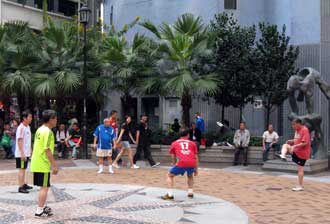 Sheung Wan Municipal Market:
across on the far side of the square, we reached
the gaunt-looking four-storey Sheung Wan Municipal Market. Fortunately this had escalators
to reach the higher floors which were filled with stalls selling even more
exotic fruit and vegetables than seen yesterday, along with butchery stalls
piled with chopped meat, and bins full of animal bones and pared jaws. On the
top floor we found an area of cafés where we sat to enjoy glasses of deliciously
refreshing iced lemon and orange Chinese tea
(Photo
53 - Iced lemon China tea). Again we were made welcome with delightful
hospitality. Sheung Wan Municipal Market:
across on the far side of the square, we reached
the gaunt-looking four-storey Sheung Wan Municipal Market. Fortunately this had escalators
to reach the higher floors which were filled with stalls selling even more
exotic fruit and vegetables than seen yesterday, along with butchery stalls
piled with chopped meat, and bins full of animal bones and pared jaws. On the
top floor we found an area of cafés where we sat to enjoy glasses of deliciously
refreshing iced lemon and orange Chinese tea
(Photo
53 - Iced lemon China tea). Again we were made welcome with delightful
hospitality.
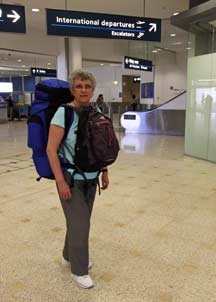 Return to Hong Kong International Airport
for onward flight to Sydney, Australia:
but our time was fast running out for further
wanderings in Sheung Wan; we had to return to North Point to collect our kit
from the hotel and make our way out to the International Airport for the onward
overnight flight to Australia. Back therefore past the mysterious Chinese medicine
shops, we made our way along the main Des Voeux Road where lines of trams
passed
(Photo
54 - Hong Kong trams), to the Sheung Wan MTR station for the Metro journey
back along to North
Point. Back at the hotel, we retrieved our packs from the store room, and sorted
kit for the onward flight to Sydney. Fully laden again with packs and day sacs,
we made our final MTR journey in the
crowded train back along to Central, glad of the moving walk-ways given the
distance through to the Airport Express station. Having paid our $160 fares, we
boarded the Express Metro back out to the airport (see right) (Photo
55 - Farewell Hong Kong). Here we checked in, glad to
be relieved of our weighty packs, passed through security and found a bar for an
expensive glass of wine at $176; Paul wrote up today's log while Sheila read up on
Sydney in readiness for our time there. Boarding began at 8-15pm and now as Qantas 'Regular Flyers', we were
welcomed back as we entered the 747 aircraft. A Chinese supper was served with
Australian wine, and we settled down for a short night's sleep, again weary
after another fulsome and rewarding day on the hill-side of Sheung Wan. Return to Hong Kong International Airport
for onward flight to Sydney, Australia:
but our time was fast running out for further
wanderings in Sheung Wan; we had to return to North Point to collect our kit
from the hotel and make our way out to the International Airport for the onward
overnight flight to Australia. Back therefore past the mysterious Chinese medicine
shops, we made our way along the main Des Voeux Road where lines of trams
passed
(Photo
54 - Hong Kong trams), to the Sheung Wan MTR station for the Metro journey
back along to North
Point. Back at the hotel, we retrieved our packs from the store room, and sorted
kit for the onward flight to Sydney. Fully laden again with packs and day sacs,
we made our final MTR journey in the
crowded train back along to Central, glad of the moving walk-ways given the
distance through to the Airport Express station. Having paid our $160 fares, we
boarded the Express Metro back out to the airport (see right) (Photo
55 - Farewell Hong Kong). Here we checked in, glad to
be relieved of our weighty packs, passed through security and found a bar for an
expensive glass of wine at $176; Paul wrote up today's log while Sheila read up on
Sydney in readiness for our time there. Boarding began at 8-15pm and now as Qantas 'Regular Flyers', we were
welcomed back as we entered the 747 aircraft. A Chinese supper was served with
Australian wine, and we settled down for a short night's sleep, again weary
after another fulsome and rewarding day on the hill-side of Sheung Wan.
Farewell to Hong Kong: although brief, our
visit to Hong Kong had given us a thorough 2 day introduction to the former
British colony which in those days still bore distinctive features of its
colonial past such as British
traffic lights, post boxes, and double-decker trams; and we saw many signs of
residual British colonial culture with the local Chinese population imitating British habits eg young girls in neat,
old-fashioned
school uniforms, and little boys in cub-scout uniforms
(Photo
56 - Residual British culture), all charmingly
reminiscent of 1950s UK with good manners and courtesy to match.
Two words for us characterise our happy recollections of Hong Kong: welcoming
and safe. Whatever time of day or night, even in some of the less salubrious
areas, we never in any way felt insecure, threatened or concerned, and it was
impossible to pause even for a moment without one or more local people coming up
and offering help; being helped unwillingly or needlessly across the road was a
regular hazard, albeit a very pleasant one! And now it was farewell Hong Kong
after a very memorable stop-over, and on to Sydney, but that's the
story for the next episode.
Second edition
from Sydney, Australia 2011 to be published soon
|
Sheila and Paul |
Published: 14 December 2020 |
|
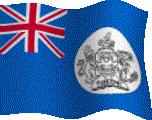
 Re-crossing the harbour, we took yet more photos
looking across towards the far bank waterfront with the highest tower on the Hong Kong Island shore ahead now illuminated
and silhouetted against
the night sky (Photo
34- Re-crossing harbour on Star Ferry), as the ferry approached the Central pier from
where we had departed earlier in the day (Photo
35 - Approaching Central ferry-pier).
Re-crossing the harbour, we took yet more photos
looking across towards the far bank waterfront with the highest tower on the Hong Kong Island shore ahead now illuminated
and silhouetted against
the night sky (Photo
34- Re-crossing harbour on Star Ferry), as the ferry approached the Central pier from
where we had departed earlier in the day (Photo
35 - Approaching Central ferry-pier).

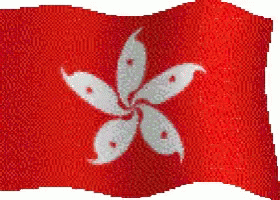
 BACK-PACKING TRIP TO AUSTRALIA 2011
- Stop-over in Hong Kong:
BACK-PACKING TRIP TO AUSTRALIA 2011
- Stop-over in Hong Kong:
 any sense of such meaningless clap-trap). But 4 weeks before our intended
April 2020 departure date for Scandinavia, lockdown-1 began. And there our web site has rested, like us in suspended animation
... until now.
any sense of such meaningless clap-trap). But 4 weeks before our intended
April 2020 departure date for Scandinavia, lockdown-1 began. And there our web site has rested, like us in suspended animation
... until now. loaded
packs and immediate requirements stowed in day-sacs (
loaded
packs and immediate requirements stowed in day-sacs ( Leicester bus station, we lumbered out for the coach; packs were stowed in the luggage hold, and we enjoyed a comfortably
relaxed journey down to Heathrow in the uncrowded coach. The weather until today had
been beautiful with warm, sunny Spring conditions, but the forecast for today
was for heavy rain, just what we did not need.
Leicester bus station, we lumbered out for the coach; packs were stowed in the luggage hold, and we enjoyed a comfortably
relaxed journey down to Heathrow in the uncrowded coach. The weather until today had
been beautiful with warm, sunny Spring conditions, but the forecast for today
was for heavy rain, just what we did not need. reasonably soundly for 6~7
hours. Our Far Eastern venture was underway.
reasonably soundly for 6~7
hours. Our Far Eastern venture was underway.
 Causeway Bay MTR station for supper amid all the shopping malls there.
Causeway Bay MTR station for supper amid all the shopping malls there. daughter to say that, despite being exhausted, we were heading out in
search
of beer, food and fun (in that order!).
We returned to the MTR station, and at
Causeway Bay emerged into the glare of characteristic Hong Kong illuminated
signs (see above left and right) (
daughter to say that, despite being exhausted, we were heading out in
search
of beer, food and fun (in that order!).
We returned to the MTR station, and at
Causeway Bay emerged into the glare of characteristic Hong Kong illuminated
signs (see above left and right) ( had to be taken of such a view. We were away early
this morning for our first full day in Hong Kong, and caught the MTR back to Central.
Our intention today was to take the peak tram funicular up to the Peak viewing
platform, given that the forecast was for clearer, less hazy sunny weather; we
should then cross the Harbour by the Star Ferry for lunch in Kowloon. Our plan
was
to spend the afternoon visiting the markets area of Kowloon, see the Light Show
from the waterfront viewing platform early evening, then return to Causeway Bay
for supper and for photographing the illuminated street signs.
had to be taken of such a view. We were away early
this morning for our first full day in Hong Kong, and caught the MTR back to Central.
Our intention today was to take the peak tram funicular up to the Peak viewing
platform, given that the forecast was for clearer, less hazy sunny weather; we
should then cross the Harbour by the Star Ferry for lunch in Kowloon. Our plan
was
to spend the afternoon visiting the markets area of Kowloon, see the Light Show
from the waterfront viewing platform early evening, then return to Causeway Bay
for supper and for photographing the illuminated street signs. tropical
trees, flower-beds and fountains, towered over by a surrounding forest of sky scraper office
blocks (see left and right) (
tropical
trees, flower-beds and fountains, towered over by a surrounding forest of sky scraper office
blocks (see left and right) ( second tram which trundled up the
peak-side passing the down-coming tram (
second tram which trundled up the
peak-side passing the down-coming tram ( , and photographing this glorious
vista
(see below right)
(
, and photographing this glorious
vista
(see below right)
( Star Ferry across
Victoria Harbour for lunch in Kowloon: we walked downhill
through the city, photographing Hong Kong's
city trams and double-decker buses (see below right) (
Star Ferry across
Victoria Harbour for lunch in Kowloon: we walked downhill
through the city, photographing Hong Kong's
city trams and double-decker buses (see below right) (
 tried an electronics shop close to the Kowloon ferry
landing stage to discover how far the price of higher value memory cards could
be haggled down. On the Nathan Road we found a more promising photographic shop; here by
persistent bargaining,
we managed to achieve a satisfyingly reasonable price for high capacity cards to
equip
tried an electronics shop close to the Kowloon ferry
landing stage to discover how far the price of higher value memory cards could
be haggled down. On the Nathan Road we found a more promising photographic shop; here by
persistent bargaining,
we managed to achieve a satisfyingly reasonable price for high capacity cards to
equip both our cameras.
both our cameras. Having tried
one grubby-looking café asking for dim sum, we were directed across the
street to where we found piles of the little baskets cooking outside an
initially unpromising café
(see left) (
Having tried
one grubby-looking café asking for dim sum, we were directed across the
street to where we found piles of the little baskets cooking outside an
initially unpromising café
(see left) ( pork dim sums, and naturally a pot of China tea. Hesitantly, and rather
inexpertly, we picked up the little round crispy parcels of meat with our chop sticks to eat
without dropping them (
pork dim sums, and naturally a pot of China tea. Hesitantly, and rather
inexpertly, we picked up the little round crispy parcels of meat with our chop sticks to eat
without dropping them ( older daughter, and after some confusion over price, succumbed to a jade pendant
for Sheila at a rather more expensive price; 'promotion' he added insistently.
We were easy victims!
older daughter, and after some confusion over price, succumbed to a jade pendant
for Sheila at a rather more expensive price; 'promotion' he added insistently.
We were easy victims! Browsing the
street markets of Kowloon:
just opposite we could see an area of open
street markets, and wandered among the stalls; all kinds of fruit and
vegetables were on display (
Browsing the
street markets of Kowloon:
just opposite we could see an area of open
street markets, and wandered among the stalls; all kinds of fruit and
vegetables were on display ( Kowloon Park: we continued through the
market, ambling among the stalls, traders and shoppers, and beyond the Jordan Road we
passed through areas of small shops selling all kinds of household goods, all so
interesting. This emerged at a more modern shopping plaza which blocked our way
forward. Around the side of this we entered the attractive Kowloon Park where we
were glad to sit a
Kowloon Park: we continued through the
market, ambling among the stalls, traders and shoppers, and beyond the Jordan Road we
passed through areas of small shops selling all kinds of household goods, all so
interesting. This emerged at a more modern shopping plaza which blocked our way
forward. Around the side of this we entered the attractive Kowloon Park where we
were glad to sit a while, weary from our wanderings, and watch the passers-by.
Birds of prey circled around the surrounding tower-blocks and exotically
coloured parakeets flitted among the trees. Sheila admired the Chinese Banyan trees (Ficus
microcarpa)
(
while, weary from our wanderings, and watch the passers-by.
Birds of prey circled around the surrounding tower-blocks and exotically
coloured parakeets flitted among the trees. Sheila admired the Chinese Banyan trees (Ficus
microcarpa)
(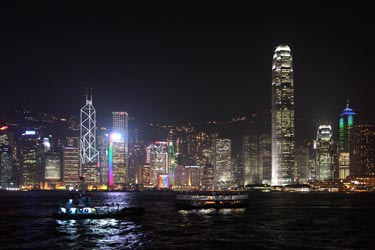
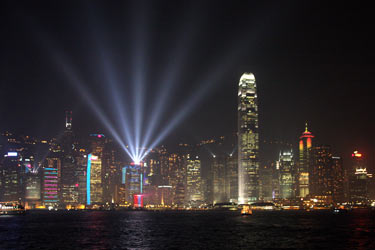
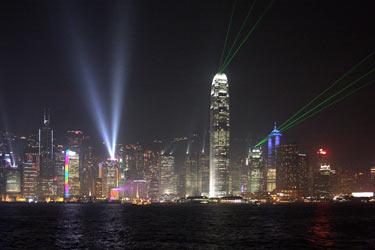
 street photos of all the illuminated
signs (
street photos of all the illuminated
signs ( Our
second day in Hong Kong
Our
second day in Hong Kong
 we turned back down the steps alongside the Escalator (
we turned back down the steps alongside the Escalator ( during the Ming and
Qing dynasties; the temple is now maintained by the Tung Wah charitable organisation
which provides hospital and school services across Hong Kong. The temple's dark
interior was filled with shrines and the air was rank with incense smoke from
burning joss sticks and smoking bell-shaped incense coils hanging from the
ceiling. Worshippers were paying homage to their Buddha statues with handfuls of
burning joss sticks.
during the Ming and
Qing dynasties; the temple is now maintained by the Tung Wah charitable organisation
which provides hospital and school services across Hong Kong. The temple's dark
interior was filled with shrines and the air was rank with incense smoke from
burning joss sticks and smoking bell-shaped incense coils hanging from the
ceiling. Worshippers were paying homage to their Buddha statues with handfuls of
burning joss sticks. A straightforward lunch in Lok Ku Street:
A straightforward lunch in Lok Ku Street: 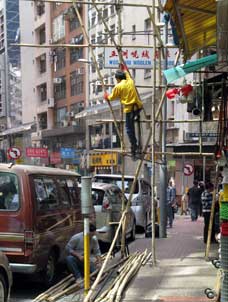
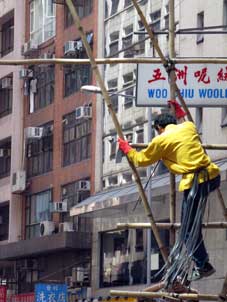
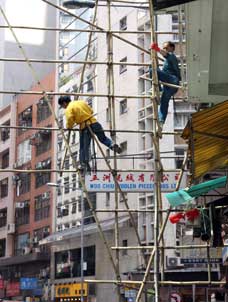
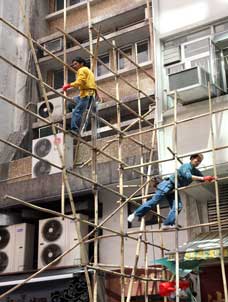
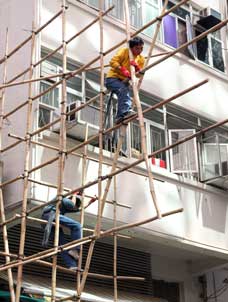

 selling all kinds of exotic and
unrecognisable dried ingredients for Chinese hokus-pokus medicine (
selling all kinds of exotic and
unrecognisable dried ingredients for Chinese hokus-pokus medicine ( Sheung Wan Municipal Market:
across on the far side of the square, we reached
the gaunt-looking four-storey Sheung Wan Municipal Market. Fortunately this had escalators
to reach the higher floors which were filled with stalls selling even more
exotic fruit and vegetables than seen yesterday, along with butchery stalls
piled with chopped meat, and bins full of animal bones and pared jaws. On the
top floor we found an area of cafés where we sat to enjoy glasses of deliciously
refreshing iced lemon and orange Chinese tea
(
Sheung Wan Municipal Market:
across on the far side of the square, we reached
the gaunt-looking four-storey Sheung Wan Municipal Market. Fortunately this had escalators
to reach the higher floors which were filled with stalls selling even more
exotic fruit and vegetables than seen yesterday, along with butchery stalls
piled with chopped meat, and bins full of animal bones and pared jaws. On the
top floor we found an area of cafés where we sat to enjoy glasses of deliciously
refreshing iced lemon and orange Chinese tea
( Return to Hong Kong International Airport
for onward flight to Sydney, Australia:
but our time was fast running out for further
wanderings in Sheung Wan; we had to return to North Point to collect our kit
from the hotel and make our way out to the International Airport for the onward
overnight flight to Australia. Back therefore past the mysterious Chinese medicine
shops, we made our way along the main Des Voeux Road where lines of trams
passed
(
Return to Hong Kong International Airport
for onward flight to Sydney, Australia:
but our time was fast running out for further
wanderings in Sheung Wan; we had to return to North Point to collect our kit
from the hotel and make our way out to the International Airport for the onward
overnight flight to Australia. Back therefore past the mysterious Chinese medicine
shops, we made our way along the main Des Voeux Road where lines of trams
passed
(